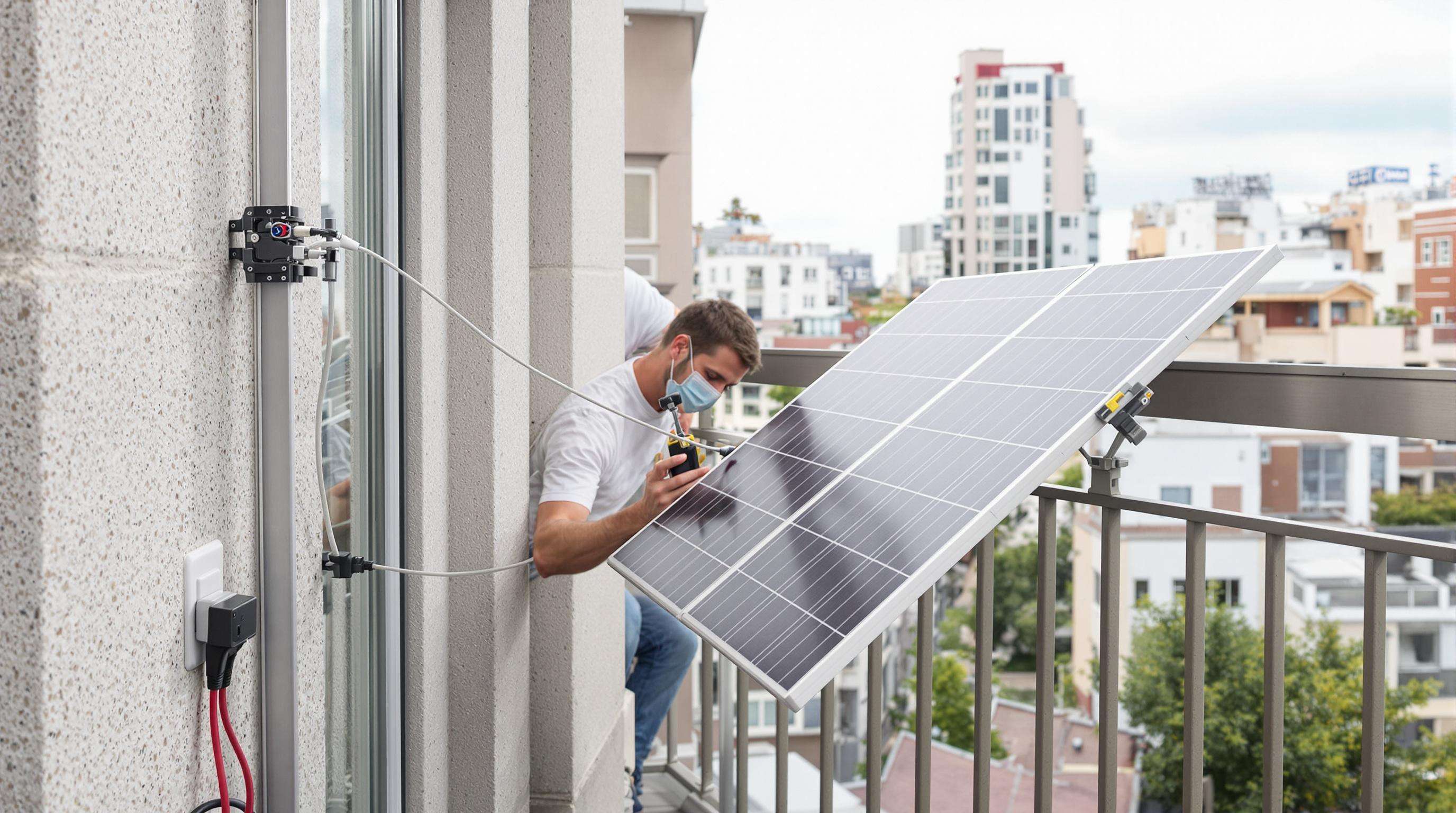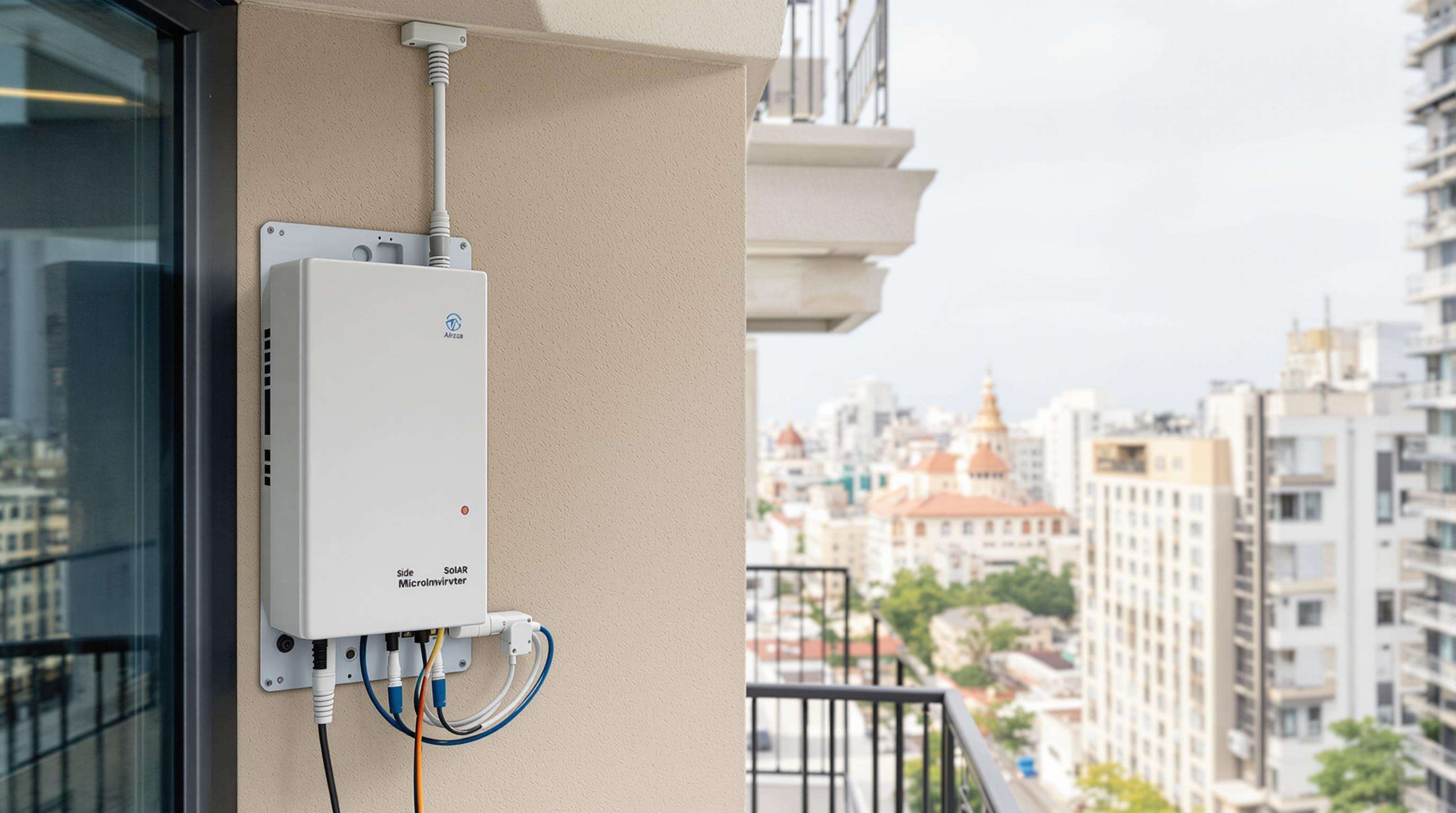يُغير ارتفاع شعبية حزم الطاقة الشمسية الخاصة بالشرانق كيفية توليد الطاقة في المدن، خاصةً في أوروبا حيث ارتفعت أعداد التركيب بنسبة 200% تقريبًا منذ عام 2021. ومن المثير للدهشة أن 38% من الأشخاص الذين يثبتون هذه الأنظمة يعيشون في شقق أو يستأجرون منازلهم، ويرجع ذلك أساسًا إلى أنها لا تحتاج إلى مساحة كبيرة ولا تُحدث أي ضرر للهيكل البنائي. وتبرز ألمانيا كدولة رائدة في هذا المجال، حيث تمتلك أكثر من نصف مليون وحدة جاهزة للاستخدام مثبتة في جميع أنحاء البلاد. وعادةً ما تقلل هذه الأنظمة فاتورة الكهرباء الشهرية للأسر بنسبة تتراوح بين 15 إلى 25 بالمئة. وتقدم مدن مثل برلين حوافز مالية بقيمة 500 يورو لتشجيع المزيد من السكان على تركيبها، وهو إجراء مفيد بشكل خاص في الأحياء المزدحمة حيث يصعب على معظم المباني الشققية العثور على مساحة كافية على الأسطح.
تُنتج حزم الطاقة الشمسية المثبتة على الشرفات الكهرباء مباشرةً على شرفات مباني المدن بفضل تلك المُحولات الدقيقة المُدمجة معها، مما يعني أنه لم يعد هناك حاجة إلى الشبكة الكهربائية المركزية الكبيرة. فخذ على سبيل المثال نظامًا متوسطًا بقوة 800 واط، فهو يُنتج عادةً حوالي 850 كيلوواط ساعة سنويًا. هذا يكفي لتشغيل جميع الاحتياجات الأساسية التي يطلبها معظم سكان الشقق الصغيرة في المدينة. وعندما يبدأ الكثير من الناس في إنتاج الطاقة محليًا بدلًا من الاعتماد فقط على محطات الطاقة البعيدة، فإن ذلك يُخفف الضغط الواقع على الشبكات الكهربائية المُثقلة. والأمر المثير للدهشة هو أن ربع سكان الشقق في الاتحاد الأوروبي تقريبًا بدأوا بالفعل في مشاركة الطاقة مع بعضهم البعض ضمن مفهوم تداول الطاقة من ند إلى ند بين الجيران.
تُصبح القوانين المتعلقة بتركيب الطاقة الشمسية أكثر بساطة، مما يُفسر سبب اتجاه المزيد من الناس إلى استخدام الطاقة الشمسية في الوقت الحالي. فعلى سبيل المثال، مررت بلجيكا قانونًا يُسمى 'قانون الشرفة الشمسية' في عام 2024 يسمح للمستأجرين بتركيب الألواح على شرفاتهم دون الحاجة إلى إذن من أصحاب العقارات. ويتبع هذا ما قامت به ألمانيا من خلال برنامج 'Balkonkraftwerk' الذي جعل من الأسهل على سكان الشقق إنتاج كهربائهم الخاص. وفي جميع أنحاء أوروبا، قامت ست دول مختلفة بإلغاء ضريبة القيمة المضافة على شراء معدات الطاقة الشمسية، وتقدم النمسا ميزة إضافية لطيفة أيضًا، وهي تقديم 250 يورو لكل كيلوواط يتم تركيبه. وتنسجم كل هذه التغييرات مع المبادرة الأوسع 'REPowerEU' التي تهدف إلى مضاعفة إنتاج الطاقة الشمسية في المدن مرتين بحلول منتصف العقد. ما يجعل هذا الأمر مثيرًا بشكل خاص هو أنه يفتح الأبواب أمام الأشخاص الذين لا يمتلكون منازل لكنهم ما زالوا يرغبون في الحصول على خيارات الطاقة النظيفة المتاحة حاليًا بفضل تلك الأنظمة القياسية القابلة للتوصيل والتشغيل التي يتم تطويرها.

تُركّز أدوات الطاقة الشمسية للشرفات هذه الأيام على جعل عملية التركيب سهلة للغاية، وذلك بفضل عدم الحاجة إلى أدوات لتثبيتها، حيث تأتي جميع المكونات الكهربائية جاهزة للاستخدام. على سبيل المثال، تشير SolarTech إلى أن نظامًا قياسيًا بقوة 400 واط يمكنه إنتاج ما بين 300 إلى 600 كيلوواط ساعة سنويًا. تعمل هذه الأنظمة مع محولات صغيرة جدًا تقوم بتحويل أشعة الشمس إلى كهرباء تيار متردد في الموقع نفسه، بدلًا من الحاجة إلى صناديق مركزية كبيرة في كل مكان. كما تضيف معظم العلامات التجارية الرائدة الآن تطبيقات للهواتف الذكية، مما يتيح لأصحاب المنازل رؤية أداء الألواح الخاصة بهم من خلال لوحة تحكم بسيطة. وتتصل الوحدات مباشرةً بمآخذ الكهرباء العادية، مما يعني أنه لم يعد من الضروري التعامل مع أسلاك معقدة. وشهدت هذه الأنظمة طفرة حقيقية في بلجيكا بعد أن غيّرت حكومتها اللوائح التنظيمية في عام 2025. وأصبحت الآن أيّة أنظمة بقوة أقل من 800 واط تُصنّف على أنها أجهزة محمولة بدلًا من اعتبارها بحاجة إلى موافقة رسمية قبل التركيب.
حلول التركيب التي لا تتطلب حفر ثقوب أو تركيبات دائمة مثل المشابك أو الإطارات الثقيلة أو تلك الأقواس الخالية من السكك الحديدية تعني عدم وجود أي ضرر على الإطلاق للهياكل. وهذا مهم للغاية لأن العديد من الأشخاص الذين يعيشون في المدن لا يمكنهم إجراء التغييرات التي يريدونها بسبب قواعد الإيجار. وجد تقرير الطاقة الحضرية لعام 2025 أن حوالي 7 من كل 10 مستأجرين في المناطق الحضرية يتجنبون إجراء أي تعديلات دائمة لهذا السبب بالضبط. عندما يتعلق الأمر بالشرفات الصغيرة حيث يكون كل شبر مهمًا، تساعد الألواح الشمسية القابلة للطي والتركيبات الرأسية على زيادة المساحة المحدودة مع الحفاظ على الممرات واضحة وسهلة الوصول إليها. ومن الجدير بالذكر أن معظم الأماكن في جميع أنحاء أوروبا لا تشترط تصاريح لأنظمة الطاقة الشمسية التي تقل عن 1 كيلوواط. وقد صنفت حوالي 90٪ من دول الاتحاد الأوروبي هذه الأنظمة الأصغر على أنها أجهزة توصيل بسيطة ذات مخاطر ضئيلة، وهو ما يفسر سبب لجوء العديد من سكان الشقق إليها على الرغم من ظروف معيشتهم المدمجة.

من حيث الأنظمة الشمسية، فإن المايكرو إنفرترز تحسن الأداء بشكل كبير لأنها تقوم بتحويل التيار المستمر إلى تيار متردد مباشرةً عند كل لوحة على حدة. أما الأنظمة التقليدية فتستخدم إنفرترات سلسلية، وفيها إذا تعرضت إحدى اللوحات للاست shade أو تراكم الأوساخ عليها، فإن النظام بأكمله يتأثر. أما مع المايكرو إنفرترز، فهذا لا يشكل مشكلة لأن كل لوحة تعمل بشكل مستقل. تشير الأبحاث في مجال الطاقة المتجددة إلى أن هذه الأجهزة قادرة على الحفاظ على نحو 96 بالمئة من إنتاج الطاقة الممكن حتى عندما تكون أجزاء من المصفوفة في الظل - وهو أمر مفيد بشكل خاص للمباني في المدن حيث تعيق الأشجار والمنشآت المجاورة وصول أشعة الشمس. بالإضافة إلى ذلك، فإن تركيبها سهل ويعتمد على مبدأ 'التركيب والتشغيل' (plug and play) مما يعني عدم الحاجة إلى أسلاك تيار مستمر عالية الجهد والتي قد تكون خطرة في الشقق، مما يجعلها خيارًا أكثر أمانًا للتركيبات السكنية التي تكون المساحة فيها محدودة.
مع محولات التيار المتناوبة اللامركزية، يعمل كل لوحة بشكل مستقل، مما يزيد الإنتاجية بغض النظر عن الاتجاهات المختلفة أو العوائق مثل الدرابزين أو المباني القريبة. كما يتيح المراقبة في الوقت الفعلي تحديد الألواح ذات الأداء المنخفض بسرعة، مما يدعم الصيانة الذاتية. وقد أظهرت الاختبارات أن تحسين مستوى الألواح يقلل من خسائر الطاقة السنوية بنسبة 20-30% مقارنة بالمحولات التقليدية، في حين تتماشى فترات الضمان التي تصل إلى 25 عامًا مع ضمانات طويلة الأجل لأنظمة الشرفات.
أثبتت دوات إنفيجن مايكرو العائدة إلى شركة إنفيجن أنها موثوقة في جميع أنواع الطقس في أوروبا، وذلك بفضل تصنيفها المائي IP67 الذي يحافظ على عملها حتى في حالات الأمطار الغزيرة أو تساقط الثلوج الجانبية. إن موديل Hoymiles HM-350 مناسب بشكل خاص للمناطق الحضرية حيث لا يكون أشعة الشمس متاحة دائماً، حيث يحقق كفاءة ملحوظة تصل إلى 96.5% حتى في الأيام الغائمة. ما يجعل هذه الخيارات جذابة لدى العديد من أصحاب المنازل هو أنها تتوافق مع معايير التوصيل والتشغيل في الاتحاد الأوروبي، مما يعني أن التركيب يتم بسلاسة دون الحاجة إلى إذن من أصحاب العقارات الذين قد يكونون مترددين بشأن مشاريع الطاقة الشمسية. بالإضافة إلى ذلك، تحتوي كلتا العلامتين على تصميمات وحدوية بحيث يمكن للمستخدمين البدء بقدرة تبلغ حوالي 600 واط والتوسع تدريجياً لتصل إلى 1.5 كيلوواط مع زيادة متطلبات الكهرباء بمرور الوقت.
تُعد الألواح الشمسية المثبتة على الشرفات حلاً لعدة مشكلات في آنٍ واحد، لأنها تأتي جاهزة للتركيب، ولا تحتاج إلى إجراء تغييرات هيكلية على المباني، وقد سبق لها اجتياز جميع الشهادات اللازمة. بدلًا من حفر الثقوب في الأسقف أو ترقية الأنظمة الكهربائية، تتصل هذه الأنظمة ببساطة بمآخذ الطاقة الخارجية العادية باستخدام محولات دقيقة تتوافق مع معايير السلامة. ولقد حدّثت الحكومة الألمانية قواعدها الخاصة بالطاقة الشمسية على الشرفات في عام 2024، مما يسمح لأي شخص بتركيب ما يصل إلى 800 واط من الألواح الشمسية دون المرور بالإجراءات المعتادة للحصول على التصاريح. وقد أدى هذا التغيير وحده إلى حوالي 220 ألف تركيب جديد في جميع أنحاء ألمانيا خلال الأشهر الستة الأولى من العام الماضي فقط. وبالنسبة للمستأجرين في جميع أنحاء أوروبا، يُعد هذا التطور مفيدًا بشكل خاص، حيث أن معظم ملاك العقارات لا يوافقون على إجراء تعديلات دائمة. في الواقع، تمنع حوالي ثمانية من كل عشرة عقود إيجار في أوروبا أي نوع من التغييرات الهيكلية على الممتلكات. لذا، فإن إمكانية تركيب الطاقة الشمسية على شرفة المنزل دون الحاجة إلى طلب إذن من مالك المبنى تُحدث فرقًا كبيرًا للأشخاص الذين يعيشون في الشقق ويرغبون في الحصول على حلول للطاقة النظيفة.
تختلف السياسات حسب المنطقة:
| المنطقة | عتبة التصريح | إشعار المالك مطلوب |
|---|---|---|
| الدول الأوروبية | €800W | 22% من الحالات |
| الولايات الأمريكية | 1 كيلو واط | تختلف حسب شروط الإيجار |
| كندا | 600 واط | تعتمد على المقاطعة |
أظهرت مبادرة غير ربحية ومقرها سان فرانسيسكو كيف تتفادى أنظمة الشرفات الوحدوية العقبات التنظيمية، وتحقق اعتمادًا من قبل 94٪ من المستأجرين دون الحاجة إلى تعديلات في عقود الإيجار. يجب على المستأجرين في المدن اختيار مجموعات معتمدة من UL ضمن حدود التصاريح المحلية (عادةً ما تتراوح بين 600 واط إلى 1 كيلوواط) لضمان الامتثال عبر الولايات القضائية المختلفة.
تأتي أحدث حزم الطاقة الشمسية بتصميمات نظيفة ووحداتية تناسب المشاهد الحضرية دون استهلاك مساحة كبيرة. تستخدم هذه الأنظمة ألواحًا رفيعة للغاية، بعضها لا يزيد سمكها عن بضع بوصات، إلى جانب أقواس قابلة للتعديل لتثبيت النظام تقريبًا في أي مكان، سواء على درابزين السور أو جدران المباني أو حتى كوحدات منفصلة في الفناءات. يساعد هذا في الحفاظ على المظهر الجمالي في المناطق الأوروبية القديمة حيث تم بناء معظم المنازل قبل عام 1980 وفقًا للدراسات الحديثة. إذ يعود ثلثا المساكن هناك إلى عقود مضت، لذا فإن الشكل الجمالي يلعب دورًا كبيرًا. في الواقع، تدمج بعض النماذج الأحدث أيضًا النباتات في التصميم. تخيل صناديق زهور تعمل بالطاقة الشمسية وتنتج ما بين 300 إلى 400 واط من الكهرباء، وفي الوقت نفسه تحسن من مظهر الحدائق. فهي تحول الوظيفة إلى جمال دون التأثير على الأداء.
تُربط المحولات الدقيقة التي تحتوي على اتصال واي فاي بين أنظمة الطاقة الشمسية تطبيقات إدارة الطاقة المنزلية وأنظمة الشبكة الذكية، مما يمكّن أصحاب المنازل من مراقبة استهلاك الطاقة لديهم في الوقت الفعلي والتفاعل عند الحاجة. يبدأ معظم الناس بمشروع صغير مثل نظام بسعة 600 واط على شرفة منزلهم، ثم يقومون بتوسيعه لاحقًا بإضافة الألواح المحمولة على الأرض. تُقلل هذه الأنظمة المختلطة فاتورة الكهرباء في الشقق بنسبة تتراوح بين 30 إلى 50 بالمئة على المدى الطويل. قام معهد فراونهوفر في ألمانيا بإجراء بعض البحوث في هذا المجال، ووجد أن هذه الأنظمة الشمسية القابلة للتوسع تقلل الضغط على الشبكة خلال ساعات الذروة بنسبة 18 بالمئة تقريبًا مقارنة بالأنظمة التقليدية ذات الوحدة الواحدة. منطقي حقًا، حيث أن الأنظمة الأكبر تعمل بشكل أفضل مقارنة بمحاولة إنجاز كل شيء باستخدام لوحة صغيرة واحدة.
وفقًا لتعديلات توجيه الطاقة المتجددة (RED III)، تم الاعتراف رسميًا بأنظمة الطاقة الشمسية للشر balcony كأجهزة للطاقة المتجددة داخل الاتحاد الأوروبي بهدف الوصول إلى 42.5٪ من الطاقة النظيفة بحلول عام 2030. هذا التصنيف يساهم في تعزيز التوقعات بأن تركيبات الألواح الشمسية على أسطح الشرفات الحضرية قد تصل إلى نحو 12 غيغاواط بحلول نهاية هذا العقد، وهو ما يكفي لتزويد ما يقارب 4.8 مليون منزل بالكهرباء وفقًا لتقرير SolarPower Europe لعام 2024. ناظرًا إلى ما يحدث في أنحاء أوروبا، قامت فرنسا وإيطاليا مؤخرًا بتسهيل عملية تركيب الألواح الشمسية الصغيرة من خلال إعفاء الأنظمة التي تقل قدرتها عن 800 واط من ضريبة القيمة المضافة. وسبقت ألمانيا غيرها في هذا المجال من خلال برنامج Solarpaket الذي أطلقته السنة الماضية، والذي شهد طفرة هائلة في الطلب، حيث نما بنسبة 214٪ سنويًا في عام 2023 وحده.
إن حزم الطاقة الشمسية للشرانق هي أنظمة ألواح شمسية مدمجة مصممة لتثبيتها على الشرانق، مما يسمح للسكان بتوليد الكهرباء بأنفسهم دون الحاجة إلى مساحة كبيرة على السطح.
في العديد من المناطق، يمكن تثبيت حزم الطاقة الشمسية للشرانق دون الحاجة إلى موافقة المالك، خاصة إذا كانت ضمن حد معين من القدرة الكهربائية يصنفها على أنها أجهزة منزلية محمولة.
عادةً ما تقلل هذه الحزم من فاتورة الكهرباء الشهرية بنسبة تتراوح بين 15 إلى 25 بالمائة، ويعتمد ذلك على حجم النظام والاستخدام.
نعم، فهي مصممة خصيصًا للشقق السكنية وعقارات الإيجار الأخرى، وتشمل أنظمة تثبيت لا تتطلب تعديلات دائمة.
تقوم المايكروإنفرترات بتحويل التيار المستمر إلى تيار متردد في كل لوحة على حدة، مما يعزز الأداء ويسمح للوحات بالعمل بشكل مستقل، وهو ما يناسب البيئات الحضرية التي تتعرض للظل أو المعاوقات.
 أخبار ساخنة
أخبار ساخنة2025-02-25
2024-11-27
2024-12-17